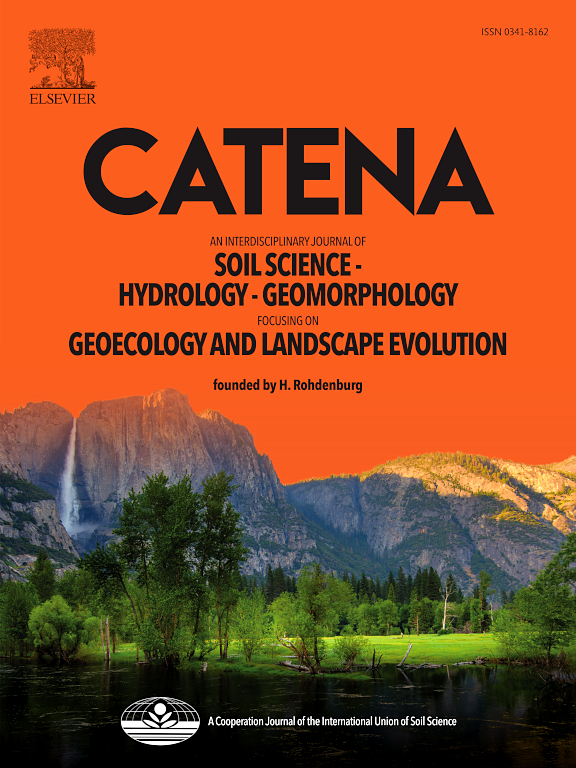IF 5.4
1区 农林科学
Q1 GEOSCIENCES, MULTIDISCIPLINARY
引用次数: 0
摘要
我们比较了德干陷阱的安比卡河和吉尔纳河这两个小型玄武岩集水区的化学风化通量。这两个集水区的气候特征截然不同:安比卡河为湿润气候,吉尔纳河为半干旱气候。我们在这些流域的次级集水区采集水样,分析其中主要离子和溶解态锶的浓度,以估算风化率并评估其控制因素。利用 ArcGIS 平台上的数字高程模型(DEM)得出流域面积、坡度和地形,并利用水土评估工具(SWAT)得出子流域尺度的径流量。SWAT 模拟的年排水量显示,安比卡河的排水量比吉尔纳河大近三倍。利用反向建模方法量化了造成溶解负荷中主要离子的各种来源,即玄武岩、碳酸盐、海盐和盐碱地(SAS)。安比卡河季风期间的总化学流失率(TCDR*)为 1033 ± 512 吨 km-2 y-1,是非季风期间(82 ± 42 吨 km-2 y-1)的 12 倍,是吉尔纳河的 3 倍(季风期间:185 ± 155 吨 km-2 y-1 与非季风期间:51 ± 25 吨 km-2 y-1)。每年,安比卡河(683 吨 km-2 y-1)的 TCDR* 是吉尔纳河(113 吨 km-2 y-1)的 6 倍。安比卡河和吉尔纳河的玄武岩(硅酸盐)风化率(BasWR)分别为 88 ± 19 吨 km-2 y-1 和 12 ± 3 吨 km-2 y-1。这两个相邻集水区的化学风化率主要受降雨/径流的控制,而地形起辅助作用。与全球大多数非活性玄武岩阴沟相比,降雨量较高的安比卡河的二氧化碳消耗率(CCR)要高得多((13 ± 4) × 105 摩尔 km-2 y-1)。本文章由计算机程序翻译,如有差异,请以英文原文为准。
Factors controlling basalt weathering in the Deccan traps: A small catchment perspective
Chemical weathering fluxes from small basalt catchments, the Ambika and the Girna in the Deccan Traps, have been compared. The two catchments are characterized by distinct climates: humid in the Ambika and semi-arid in the Girna River. We collected water samples at the sub- catchment scale of these basins and analysed concentrations of major ions and dissolved Sr in them to estimate the weathering rates and to assess their controlling factors. The catchment area, slope and relief of the catchments were derived using Digital Elevation Model (DEM) on ArcGIS platform whereas the Soil and Water Assessment Tool (SWAT) was used to derive the sub-catchment scale runoffs. The SWAT simulated annual discharge shows a nearly three times larger discharge in the Ambika River compared to the Girna River. The various sources, viz., basalt, carbonates, sea-salts and saline alkaline soils (SAS) contributing to major ions in dissolved load, were quantified using inverse modelling approach. The total chemical denudation rates (TCDR*) during monsoon, 1033 ± 512 tons km−2 y-1, is ∼ 12 times higher compared to non-monsoon (82 ± 42 tons km−2 y-1) in the Ambika River, and ∼ 3 times higher in the Girna River (monsoon: 185 ± 155 tons km−2 y-1 vs. non-monsoon: 51 ± 25 tons km−2 y-1). Annually, TCDR* is around 6-fold higher in the Ambika River (∼683 tons km−2 y-1) than in the Girna River (∼113 tons km−2 y-1) at their outlets. Basalt (silicate) weathering rates (BasWR) in the Ambika and the Girna rivers are 88 ± 19 and 12 ± 3 tons km−2 y-1, respectively. The chemical weathering rates in the two adjacent catchments is primarily controlled by rainfall/runoff, while relief plays secondary control. CO2 consumption rates (CCR) of the Ambika with higher rainfall are much higher ((13 ± 4) × 105 mol km−2 y-1) compared to most of the inactive basalt cathchments globally.
求助全文
通过发布文献求助,成功后即可免费获取论文全文。
去求助
来源期刊

Catena
环境科学-地球科学综合
CiteScore
10.50
自引率
9.70%
发文量
816
审稿时长
54 days
期刊介绍:
Catena publishes papers describing original field and laboratory investigations and reviews on geoecology and landscape evolution with emphasis on interdisciplinary aspects of soil science, hydrology and geomorphology. It aims to disseminate new knowledge and foster better understanding of the physical environment, of evolutionary sequences that have resulted in past and current landscapes, and of the natural processes that are likely to determine the fate of our terrestrial environment.
Papers within any one of the above topics are welcome provided they are of sufficiently wide interest and relevance.
 求助内容:
求助内容: 应助结果提醒方式:
应助结果提醒方式:


